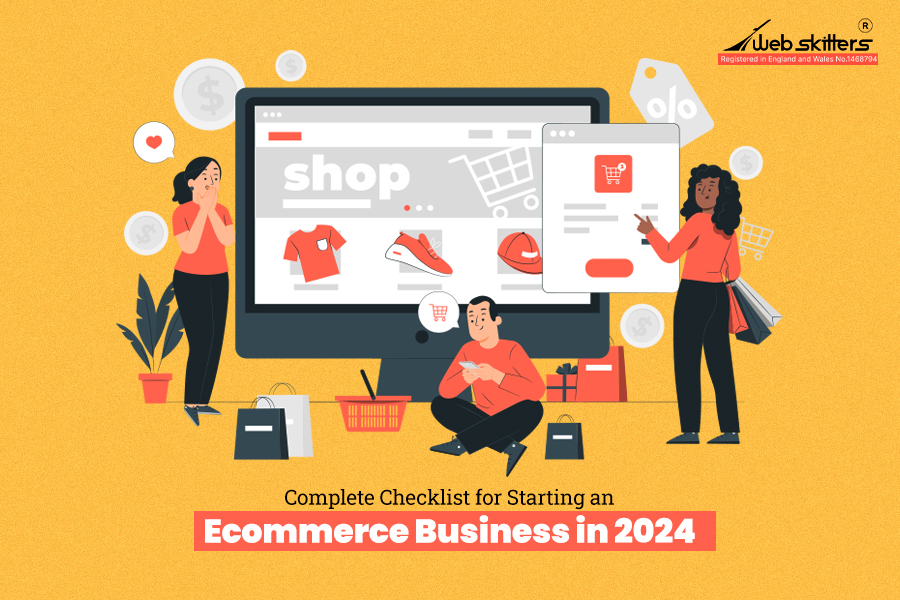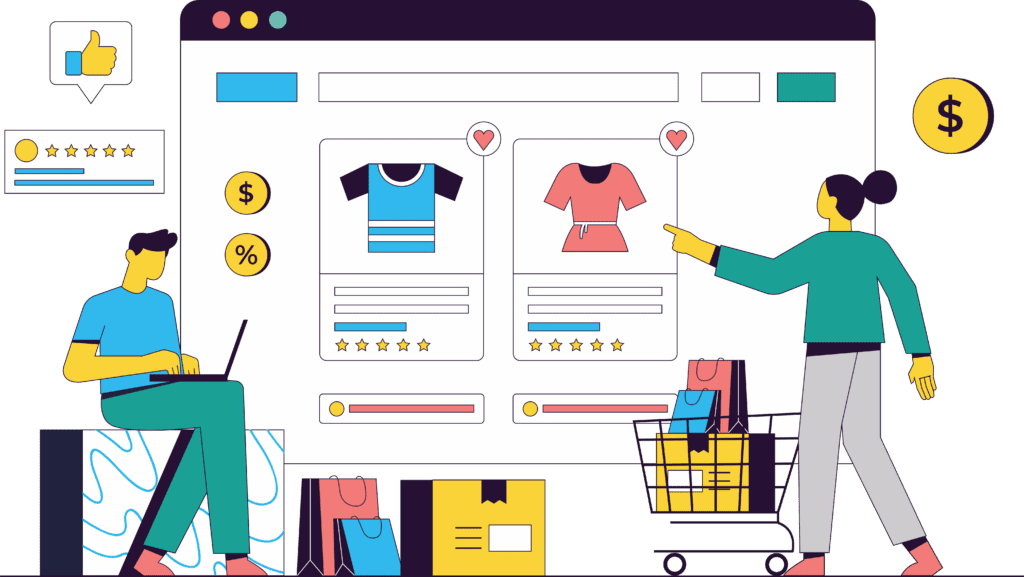The idea of kickstarting an e-commerce business is enticing – all hail to the growing potential of the online industry. The rapidly engulfing digital world has turned tons of traditional business owners towards the online retail trade. With quick access to the internet and electronic devices, surfing and online shopping is at its epitome.
Let’s take you through some impressive numbers. As we speak, the United Kingdom stands with the third largest e-commerce market, with a promising revenue expansion of up to $285 billion dollars by 2025.
Sounds amazing, doesn’t it? There’s more – the number of online retail users is likely to hit a whopping 60 million by the end of 2023.
So, if you are next in line to start an e-commerce business in the UK in 2024, we understand your excitement and are ready to guide you.
A lot goes into starting an online store and ecommerce development from understanding the e-commerce market and deciding upon a niche to breaking through financial milestones and marketing necessities.
We are here with the ultimate e-commerce launch checklist for 2024 that can help you succeed in your e-commerce journey. Dive in.
Checklist for Starting Ecommerce Business in 2024
Market Research and Planning
Market Research is the first and most crucial step to start your ecommerce business – it is the ultimate make-or-break factor. Effective marketing research tells you every minute detail about your potential audiences, the viability of the product or service as well as marketing strategies to focus on.
While there are multiple ways to perform Market research, here are 3-prime areas to focus on:
1. Studying the Demographic Region – Who are you selling to?
This involves studying the GDP per capita, monthly income, demographic size, and population range.
Keeping this information handy means knowing the buying power and making an informed decision about picking the products and deciding upon their pricing.
2. Understanding the E-commerce Trends – What’s the talk of the town?
There are multiple niches to target within the e-commerce industry – clothing, skincare, electronics, home essentials, books, groceries and more. Each domain has its specific market size, growth rate, retail barriers, purchase frequency, digital consumption and more. The information gathered can help you understand market penetration levels and leverage marketing.
3. Competitor Analysis – Who are the mammoths?
Once decided upon the domain or niche, one great way to plan further is by studying the competitor in the domain. These businesses are there for a fair while, already doing what you have planned; it is only smart to learn from them. By competitor analysis, we mean understanding their product range, pricing, return and shipment, USP and website – everything that adds value to the research.
Apart from these, two other valuable part of market research is social media analysis and consumer behaviour. It involves the social media presence of the preferred niche or service, the engagement rate, the number of followers, likes and comments. There are several new marketing mediums to uncover – such as shop-able videos, micro and macro influencers, content and UGCs.
Consumer Behaviour, on the other hand, focuses on factors that trigger buying decisions. This involves shopping frequency, spending habits, delivery and return options, etc. These factors help improve inventory management, product or service options and more.
Once done, here are 6-takeaways from proper market research that you can implement into further business planning –
- The DEMAND of your product or service.
- The SIZE of the potential market.
- The FINANCIAL RANGE of the potential buyers.
- The LOCATION of the target market.
- The SATURATION level of the product or service.
- The AMOUNT customers are willing to pay.
Ecommerce Business Plan
Picking a niche is intimidating, and building a solid e-commerce plan – even more. To put it simply, an e-commerce business plan is a formal documentation of the entire business structure. It includes e-commerce business ideas, financial structure, business niche, purpose and goals, competitors and likewise.
Importance of SWOT Analysis for Ecommerce Business Plan
Often overlooked, SWOT analysis – Strengths, Weaknesses, Opportunities and Threats – is a concrete framework that caters to real-time business problems. Strengths and Weaknesses are internal factors that focus on benchmark standards. Opportunities and Threats, however, are aligned with the competitors.
The objective of a SWOT analysis is to identify one’s position in the industry and explore the room for improvement as an e-commerce business. While SWOT analysis is time-consuming, it is indeed a worthwhile manoeuvre in the ever-evolving e-commerce domain.
So, a solid business plan along with a SWOT analysis immediately helps you answer business-related queries. Such as – Can you launch a new product? Is the product aligned with the business goal? Is the inventory in stock? Are the suppliers in line? Can you offer a discount this week? Has the XYZ competitor changed their marketing strategies? – A documentation that answers it all.
Did you know? A recent study by Harvard Business Review concluded entrepreneurs who maintain a formal business plan are 16% more successful compared to ones, who do not.
Legal and Regulatory Considerations
Understanding Ecommerce Business Structure
Before your business idea comes to life, here’s a quick overview of the four primary business structures in the UK. This information is not just meant for business acumen but rather manipulates taxes and operations.
-
Sole Proprietorship or Sole Trader
This structure refers to the business entity owned and managed by a sole individual. It is a default business structure for anyone selling any product or service.
-
General Partnership
GP Business structure is where you and your partner(s) own the business together and share responsibility and liabilities, inclusive of profits, debts, losses, etc.
-
Limited Partnership
LP business structure limits the legal and financial liabilities of the partners involved in the business. One must register their business to Companies House, submit annual reports to HM Revenues & Customs and Companies Houses, pay corporate tax, and appoint a director or board of directors.
-
Limited Liability Partnership (LLP)
LLP business requires at least two partners with limited liability to business legal claims. Each partner’s shares are individually taxed as income and they are registered as self-employed with HMRC.
Permits and Licenses – Ecommerce Store Launch Requirements
As mentioned in the Electronic Commerce (EC Directive) Regulations 2002 and Companies Act 2006, online businesses must provide the following on their website, at a minimum:
- Name
- Address
- Email Address
- Registration Number or Identification
- Limited Company Registration or VAT (if applicable)
- Clear pricing details (Delivery costs or VAT details)
- Trade bodies or professional associations if needed.
- Terms and Conditions
- Cookie Policy (if any)
- Updated and Accessible Privacy Policy
- Disclaimers (if any) to avoid liability
- Consumer Contracts and Cancellation Rights*
*The Consumer Contracts Regulations 2013 presses responsibilities on e-commerce operators and offers consumers cancellation rights. One must offer consumers, to cancel any online contract within 14 days (about 2 weeks).
E-commerce Website Development and Design
Since yours is an online store, the prime attraction is meant to be your website, where conversions take place. One thing that has always ruled the e-commerce domain is user-friendly online stores.
While the intricacies of ecommerce web development and design will vary according to business size, the core objective will remain the same – a visually compelling and user-friendly e-commerce store.
Here are the steps to begin with e-commerce website development and design –
-
Domain Name and Web Hosting
Choosing a domain name is a crucial step and something that will hold the brand value of your ecommerce business. It will be your website’s name and your consumers will type this on the address bar to access the online store. Choose a name that is easy to spell, short yet catchy and relevant to your business.
There are several platforms to avail of a domain name – GoDaddy, Bluehost, HostGator, Hostinger and more. Whichever hosting solution you pick will have an impact in terms of speed and performance. Remember, most potential customers are looking for a smooth and speedy checkout.
Also, your customers will enter personal and payment details – ensure the website is secure. You will have to purchase a Secure Sockets Layer (SSL) certificate for the website. For the payment portal, add an Address Verification System (AVS) and Credit Card Verification Value (CVV).
-
Choosing the Right E-commerce Platform
The first step to starting an ecommerce business from scratch is picking a platform as the foundation. There are multiple platforms to choose from, each with their unique features. One can pick, quick templates to start their ecommerce business. However, customisation options are available as well for added functionality.
Here are the best e-commerce platforms
- Shopify
- Magento
- WooCommerce
- BigCommerce
Product Sourcing and Inventory Management
While there is no shortage of e-commerce business ideas in 2024, it does require a well-thought-out strategy for product selection and inventory management. These are foundational aspects of the e-commerce launch checklist and can significantly impact the success of your venture.
- Selecting the right products to sell is not just about personal preference but rather a data-driven and strategic process. Here’s a quick guide:
- Market Research: Understanding your target audience: What are their needs, preferences, and pain points?
- Competitive Analysis: Learn what your competitors have to offer. Look for opportunities to differentiate your business by offering unique products or better variations of existing ones.
- Supplier Relationships: Establish strong relationships with reliable suppliers. Sourcing quality products at competitive prices is the key.
- Efficient inventory management is crucial for controlling costs and meeting customer demands. Consider these strategies:
- Understand the loopholes of inventory management – when to reorder or restock, how long the stock will last, how much restocking is needed, and so on.
- Use proficient inventory management software to monitor stock levels, track sales, and generate reports for data-driven decisions.
- Learn the various methods of inventory audit: Par level or safety stock, First in First out (FIFO), ABC Management.
- Just-In-Time (JIT) Inventory: Maintain low inventory levels and order new stock only as needed, reducing storage costs.
- Use historical data and market trends to forecast demand accurately – this is termed demand forecasting.
Marketing and Promotion
Effective marketing and promotion are essential steps for your newly launched ecommerce business. The goal is to reach your target audience and drive traffic in this ever-evolving digital landscape. Digital marketing offers various strategies to connect with potential customers and boost sales.
Here are the top three:
- SEO (Search Engine Optimization): Optimizing for the search engines to rank higher than your competitors. It involves using relevant keywords, optimising content, and improving site structure. In 2024, SEO remains a fundamental strategy to increase organic traffic and improve visibility.
- Social Media Marketing: Platforms like Facebook, Instagram and Twitter are powerful tools for connecting with your audience. Creating engaging content, running targeted ads, and leveraging influencer partnerships to reach potential customers.
- Email Marketing: This is a cost-effective way to nurture leads and turn them into customers. Personalised and segmented custom email campaigns can yield high conversion rates.
The effectiveness of digital marketing channels can vary based on your target audience and niche. However, here are some general statistics:
- SEO can lead to a 14.6% conversion rate, making it one of the most effective online marketing channels.
- Social media advertising can reach about 3 billion monthly active users on Facebook alone, offering a vast audience.
- Email marketing has an average ROI of 42:1 (sometimes more), making it a highly profitable channel.
Content Marketing
Content marketing involves engaging visitors or potential customers with valuable, relevant content. In the e-commerce domain, it’s vital for several reasons:
- Building Trust: Quality content helps establish your brand as an authority in your niche, fostering trust among potential customers.
- SEO Benefits: Content creation, such as blog posts and product descriptions, can improve your website’s SEO, driving organic traffic.
- Customer Education: Informative content helps customers make informed purchasing decisions, reducing returns and improving satisfaction.
Here’re some content marketing data that has resulted in e-commerce success:
- Websites with blogs have 434% more indexed pages, which can lead to more organic search traffic.
- Businesses that blog regularly generate 126% more leads.
- 61% of consumers are more likely to buy from companies that offer tailored content.
Paid Advertising
Paid advertising is meant to complement organic efforts by quickly reaching a targeted audience. Here’s how Google Ads and Facebook Ads can benefit your e-commerce business:
- Google Ads: These text and display ads appear on Google search results and partner websites. They are effective for capturing users actively searching for products or information.
- Facebook Ads: With advanced targeting options, Facebook Ads are ideal for reaching specific demographics and interests, allowing you to showcase products to potential customers who might not be actively searching.
The statistic of paid advertising is impressive as well
- The average ROI for Google Ads is around 200%, meaning every $1 spent is $2 in return.
- The average click-through rate (CTR) for Facebook Ads is 0.90% for all industries.
- Best marketing practices include split-testing ad creatives, using retargeting, and monitoring ad performance to adjust in real-time.
Payment and Security
Your online store can be impressive and the product unique but a poorly set payment gateway can lead to customer loss almost immediately. Allow us to explain the importance of a smooth functioning payment gateway, and how to set up one.
Payment Gateways are third-party tools that allow your customers to pay for your products or services. You will need to integrate one using an API provided by the payment service.
How to Setup a Payment Gateway?
The process may vary, depending upon the payment gateway tool and your e-commerce website’s architecture. Here’s a simple step to integrating one –
- Select a payment gateway that meets your business needs and size. When deciding upon one, consider the following factors – types of payment accepted, transaction fees, security measures, and compatibility with your e-commerce store.
- Set up a merchant account. Depending upon the payment gateway, you may or may not need a merchant account.
- Once done, obtain the API key – It is a unique identifier required to connect the e-commerce store with the payment gateway.
- Integrating the payment gateway once again depends on both factors – the gateway and the e-commerce store. For some platforms, such as WooCommerce and Shopify, you will find plugins making integration simple.
- Testing the gateway before going live is essential. Most gateways offer a ‘sandbox’ of test purchases to ensure the deed is done.
Note: Always use encrypted and secure connections and comply with the Payment Card Industry Data Security Standard (PCI DSS) when dealing with customer data.
Before you set your first payment gateway, here are some future digital payment trends to look up to in 2024
- Prediction is that 7 out of 10 e-commerce stores in the UK will offer Buy Now and Pay Later options.
- 89% of UK consumers are mobile shoppers, so a mobile-first mentality is the way for e-commerce.
- It is a Debit Card that rules and not credit. 75% of customers opted for debit cards online, followed by 70% who used PayPal.
The Need for Security Measures
The paradigm shift to everything digital is indeed exciting. However, not free from danger, specifically from cyber danger.
Cyber Security is meant to safeguard and protect customer data inclusive of their addresses, card information, contact numbers and so on. There are multiple variants of cyber threats – phishing, malware, ransomware, e-skimming, and more.
While malicious intent is at the loose, cyber security measures offer reliability and authenticity to the e-commerce business as well as their consumers.
Hence, cyber security measures are unavoidable and indispensable.
Customer Service and Logistics
As a Salesforce survey indicates, 88% of e-commerce consumers believe, the company experience is equally valuable to the product or service experience.
The modern shopper out there demands improved communication channels and tailored customer service experience – call back options, chat windows, prompt responses and text messages. Hence, emphasising top-notch customer service is the key to success.
Here is some data-driven information for your newly launched e-commerce store –
- HubSpot claimed that 68% of customers are willing to pay more for their online purchases in return for excellent customer service.
- Khoros pointed out that 86% of the time, great customer service has turned one-time clients into long-term brand loyalists.
- 89% of the customers are up for a second purchase after a positive customer service experience, says Salesforce Research.
Order Fulfilment
Simply put, order fulfilment in logistics is the systematic flow of receiving, processing and delivering products to the customers.
The fulfilment process begins with a customer placing an order and the end point is when they receive it.
Order fulfilment can be a complex process and even expensive hence, several e-commerce businesses opt for a variety of fulfilment methods, one that suits their business.
Here are the four types of Order Fulfilment method
- In-House Order Fulfilment – Self-employees to manage the fulfilment process.
- Outsourced Order Fulfilment – Where the shipping, storing and order processing is handled by a third-party logistics company.
- Drop shipping – Similar to outsourced; only there is no inventory. When an item is ordered, the retailer obtains it from a third-party supplier.
- Hybrid Fulfilment – A mix of all the above three order fulfilment options for a flexible delivery approach.
For a brand-new e-commerce business like yours, here are some delivery statistics to get inspired from
- 50% of UK online shoppers are willing to pay more for faster delivery.
- 49% of visitors are likely to hit the Buy Now button if there’s a fast delivery option.
- To 41% of European online consumers, speed is of the essence, which further leads to trust, word-of-mouth marketing, captured interest and more.
Analytics and Growth
Data analytics is paramount for e-commerce success. Imagine the things you can gain through the data generated from the umpteenth number of transactions. Starting from customer behaviour to a probable trend, here’s why data analytics is a positive knowledge to leverage –
- Better understanding of customers’ shopping behaviour that can be utilized for marketing, product recommendations and more. Thus improving customer engagement rate.
- Effective inventory management by identifying the star products and making informed decisions on restocking.
- Analysing sales data to identify profitable items and opt for an improved pricing strategy.
- Channelling customer behaviour data for marketing strategies and tracking campaign performances.
As an e-commerce business boom, effectively using data analytics will prove to be an advantageous factor. Data-driven e-commerce businesses are lined up for success statistics have proven so. According to Mckinsey Global Institute, these data-driven businesses, 23% of the time, will acquire a customer, are six times more likely to retain a customer and are 19 times more profitable in the e-commerce market.
Scaling Your Ecommerce Business with this Ultimate Checklist
The idea is not just to start an online store but to scale one for future success. This checklist ensures your business achieves a strong foundation. Before you head out to expand, the business goals need to be on point.
Here are some smart business goals to set if scaling is the ultimate mountain top
- Build an ultimate marketing strategy – test and improvise.
- Invest in automation or outsourcing.
- Excellent customer service is the way to go.
- Refine your website from time; ensure it is fast and user-friendly.
- Utilize reviews.
Wrapping Up
Launching an e-commerce business is very similar to setting up a traditional one. All you need is the correct information about where to start, and you are good to go. This checklist for starting an e-commerce business is a good one to begin.
However, if this checklist is too overwhelming, Webskitters LTD will take it up. We are the top Ecommerce Development Company in London with the best team of professionals. Contact us with your eCommerce business idea; we will bring it to life.
Let’s go digital!







